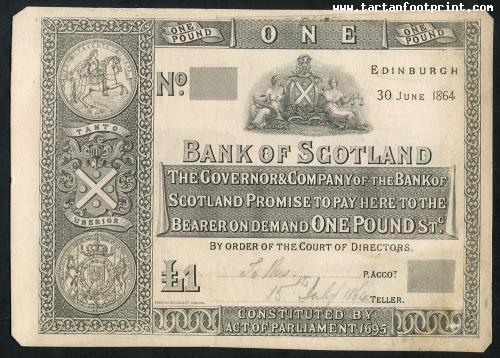You seem to be using an older version of Internet Explorer. This site requires Internet Explorer 8 or higher. Update your browser here today to fully enjoy all the marvels of this site.
May 9, 2018 by Alexander Meldrum
Scottish Bank Notes from the 18th Century to today.
In the 18th century after the Union of parliaments and "Monetary Union" at that time, exchange rates were fixed at £12 Scots to £1 sterling and n...Scottish Bank Notes from the 18th Century to today.
In the 18th century after the Union of parliaments and "Monetary Union" at that time, exchange rates were fixed at £12 Scots to £1 sterling and notes were sometimes issued expressed in both currencies.
Early notes were printed in black only. It was not until September 1777 that the Royal Bank of Scotland pioneered the use of colour in banknotes with a blue rectangle displaying the words ´one Guinea´ and the Kings head shown in red.
Colour did not come into widescale use for nearly a century later. Banknotes were originally printed on one side only.
Banknotes provided a crucial part of the currency of Scotland and in the 18th and early 19th Century and competed vigorously with coins.
There were times, for example, when £1 notes were torn into halves and quarters and were accepted as 10 shillings (50p) or 5 shillings (25p) in coin. [see also 5 shilling note issued in Napoleonic war]
The attempts to prevent forgery from a skilled engraver were certainly not on the scale of today´s complex designs.
The main deterrents were a water-marked paper, a mezzo-tint portrait of George II, an embossed bank seal and the signature of the Cashier.
The accepted Scots punishment at that time of death or amputation of hand and/or tongue may have proved more effective! As printing capabilities developed in the 19th century.
Designs became more and more complex to deter forgery - the banks always trying to keep one step ahead.
Stamp Duty was first levied on bank notes in 1783. At first the Stamp Duty related only to those over one guinea but by 1800 it had to be paid on every banknote.
Under the Act the paper had to be stamped before each note was printed. Stamping the paper was a lengthy process as it involved the Scottish banks travelling to the Stamp Office in London by stagecoach.
In 1808 the Scottish banks were granted the concession of issuing their notes on unstamped paper and paying the duty in a lump sum.
Banknotes of Scotland
Pound Sterling that are issued by the Scottish banks and in circulation in Scotland. The issuing of banknotes by retail banks in Scotland is subject to the Bank Charter Act 1844, the Banknotes (Scotland) Act 1845,
the Currency and Bank Notes Act 1928, and the Coinage Act 1971. Currently, three retail banks are allowed to print notes for circulation in Scotland: Bank of Scotland, Royal Bank of Scotland, and Clydesdale Bank.
Scottish banknotes are unusual, first because they are issued by retail banks, not central banks, and second, because they are technically not legal tender anywhere in the United Kingdom – not even in Scotland.
As such, they are classified as promissory notes, and the law requires that the issuing banks hold a sum of Bank of England banknotes or gold equivalent to the total value of notes issued.
The fact that the notes are defined as legal currency means they are not withdrawn from circulation in the same way as the Bank of England notes cease to be legal tender on a given date.
Instead the Scottish banks withdraw old notes from circulation as they are banked. Any notes still in circulation continue to be honoured by banks, but retailers may refuse to accept older notes.
Legal Tender
An interesting feature of the Scottish banknotes issue has been the fact that they have never, apart from under temporary provisions introduced in both World Wars, been "legal tender" even in Scotland,
although they are, of course, accepted as legal currency. Today, in fact, no banknotes whatsoever (including Bank of England notes!) qualifies for the term "legal tender"
north of the Border and the Scottish economy seems to manage without that legal protection.
It should be noted that all Scottish bank notes, even designs which are no longer issued or by banks which no longer operate can still be redeemed by the banks which issued them (or which subsequently took them over).
Of course, if you have old notes they may well be worth more than face value to a note collector!
In this photo:


 Alexander Meldrum likes this.
Alexander Meldrum likes this.